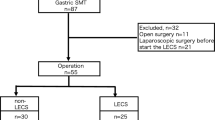Abstract
Background
Laparoscopic sleeve gastrectomy (LSG) is a relatively new bariatric surgical procedure to reduce weight in morbidly obese patients, with an overall low rate of complications and thus gaining a worldwide popularity. It provides an opportunity to study the pathology of the stomach in obese patients. Most studies, however, focused on clinical aspects, surgical techniques, and postoperative complications. Few authors studied the histopathologic findings. Whether routine histopathologic examination is warranted in patients with grossly unremarkable LSG specimens and nonsignificant clinical history was not previously studied.
Methods
We conducted a prospective study over 8 years to compare the prevalence, the morphologic spectrum and importance of histopathologic findings, and the frequency of incidental neoplasms in LSG specimens with other studies. We also proposed a protocol for the gross handling and sectioning of LSG specimens.
Results
We found 546 LSG specimens. Five patients developed iatrogenic postoperative complications, two of which pursued a medicolegal case. There was no association between the histopathologic findings and the complications. Less than 1 % of incidental benign lesions were found. No malignancies were identified. All of the patients without postoperative complications had uneventful outcome after 5 months to 6 years follow-up.
Conclusions
Routine microscopic examination of all LSG specimens is not necessary. Selective microscopic examination guided by relevant clinical history and macroscopic examination is a better option. This protocol will save money, time, and workload without compromising patient’s safety and future management. However, a careful gross description is still necessary in certain cases for potential future medicolegal implications.

Similar content being viewed by others
References
Deitel M, Gagner M, Erickson AL, et al. Third international summit: current status of sleeve gastrectomy. Surg Obes Relat Dis. 2011;7(6):747–59.
Neff KJH, le Roux CW. Bariatric surgery: a best practice article. J Clin Pathol. 2013;66(2):90–8.
Rawlins L, Rawlins MP, Brown CC, et al. Sleeve gastrectomy: 5-year outcomes of a single institution. Surg Obes Relat Dis. 2013;9(1):21–5.
Behrens C, Tang BQ, Amson BJ. Early results of a Canadian laparoscopic sleeve gastrectomy experience. Can J Surg. 2011;54(2):138–43.
Almazeedi S, Al-Sabah S, Al-Mulla A, et al. Gastric histopathologies in patients undergoing laparoscopic sleeve gastrectomies. Obes Surg. 2013;23(3):314–9.
Gundogan M, Calli Demirkan N, Tekin K, et al. Gastric histopathological findings and ghrelin expression in morbid obesity. Turk Patoloji Derg. 2013;29(1):19–26.
Albawardi A, Almarzooqi S, Torab FC. Helicobacter pylori in sleeve gastrectomies: prevalence and rate of complications. Int J Clin Exp Med. 2013;6(2):140–3.
Ahmed A. Histopathological spectrum of laparoscopic sleeve gastrectomies in King Fahd Hospital of the University, Al-Khobar, Saudi Arabia. KMUJ. 2012;4(2):39–44.
Beltran MA, Pujado B, Mendez PE, et al. Gastric gastrointestinal stromal tumor (GIST) incidentally found and resected during laparoscopic sleeve gastrectomy. Obes Surg. 2010;20(3):393–6.
Sanchez BR, Morton JM, Curet MJ, et al. Incidental finding of gastrointestinal stromal tumors (GISTs) during laparoscopic gastric bypass. Obes Surg. 2005;15(10):1384–8.
Yuval JB, Khalaileh A, Abu-Gazala M, et al. The true incidence of gastric GIST—a study based on morbidly obese patients undergoing sleeve gastrectomy. Obes Surg. 2014;24:2134–7.
Sohn VY, Arthurs ZM, Martin MJ, et al. Incidental pathologic findings in open resectional gastric bypass specimens with routine cholecystectomy and appendectomy. Surg Obes Relat Dis. 2008;4(12):608–11.
Peromaa-Haavisto P, Victorzon M. Is routine preoperative upper GI endoscopy needed prior to gastric bypass? Obes Surg. 2013;23(6):736–9.
Almazeedi S, Al-Sabah S, Alshammari D, et al. The impact of Helicobacter pylori on the complications of laparoscopic sleeve gastrectomy. Obes Surg. 2014;24(3):412–15.
Keren D, Matter I, Rainis T, et al. Sleeve gastrectomy leads to Helicobacter pylori eradication. Obes Surg. 2009;19(6):751–6.
Jossar GH. Complications of sleeve gastrectomy: bleeding and prevention. Surg Laparosc Endosc Percutan Tech. 2010;20(3):146–7.
Braghetto I, Csendes A, Korn O, et al. Gastroesophageal reflux disease after sleeve gastrectomy. Surg Laparosc Endosc Percutan Tech. 2010;20(3):148–53.
Zundel N, Hernandez JD, Galvao Neto M, et al. Strictures after laparoscopic sleeve gastrectomy. Surg Laparosc Endosc Percutan Tech. 2010;20(3):154–8.
Triantafyllidis G, Lazoura O, Sioka E, et al. Anatomy and complications following laparoscopic sleeve gastrectomy: radiological evaluation and imaging pitfalls. Obes Surg. 2011;21(4):473–8.
Martin M, Burrell MA, Gomez-Ambrosi J, et al. Short- and long-term changes in gastric morphology and histopathology following sleeve gastrectomy in diet-induced obese rats. Obes Surg. 2012;22(4):634–40.
van Vliet JL, van Gulik TM, Verbeek PC. Is it necessary to send gallbladder specimens for routine histopathological examination after cholecystectomy? The use of macroscopic examination. Dig Surg. 2013;30(4–6):472–5.
Deng YL, Xiong XZ, Zhou Y, et al. Selective histology of cholecystectomy specimens—is it justified? J Surg Res. 2015;193(1):196–201.
Alvi A, Vartanian AJ. Microscopic examination of routine tonsillectomy specimens: is it necessary? Otolaryngo Head Neck Surg. 1998;119(4):361–3.
Williams MD, Brown HM. The adequacy of gross pathological examination of routine tonsils and adenoids in patients 21 years old and younger. Hum Pathol. 2003;34(10):1053–7.
Lohsiriwat VL, Vongjirad A, Lohsiriwat D. Value of routine histopathologic examination of three common surgical specimens: appendix, gallbladder, and hemorrhoid. World J Surg. 2009;33(10):2189–93.
Ramraje SN, Pawar VI. Routine histopathologic examination of two common surgical specimens-appendix and gallbladder: is it a waste of expertise and hospital resources? Indian J Surg. 2014;76(2):127–30.
Matthyssens LE, Ziol M, Barrat C, et al. Routine surgical pathology in general surgery. Br J Surg. 2006;93(3):362–8.
Conflict of Interest
The authors declare that they have no competing interests.
Statement of Informed Consent
Informed consents were obtained from all individual participants included in the study.
Statement of Human and Animal Rights
All procedures performed in studies involving human participants were in accordance with the ethical standards of the institutional and/or national research committee and with the 1964 Helsinki declaration and its later amendments or comparable ethical standards.
Funding
There are no sources or grants of financial support from any institution to be disclosed and no conflict of interests to be disclaimed or financial disclosure to be declared.
Author information
Authors and Affiliations
Corresponding author
Rights and permissions
About this article
Cite this article
AbdullGaffar, B., Raman, L., Khamas, A. et al. Should We Abandon Routine Microscopic Examination in Bariatric Sleeve Gastrectomy Specimens?. OBES SURG 26, 105–110 (2016). https://doi.org/10.1007/s11695-015-1726-3
Published:
Issue Date:
DOI: https://doi.org/10.1007/s11695-015-1726-3




